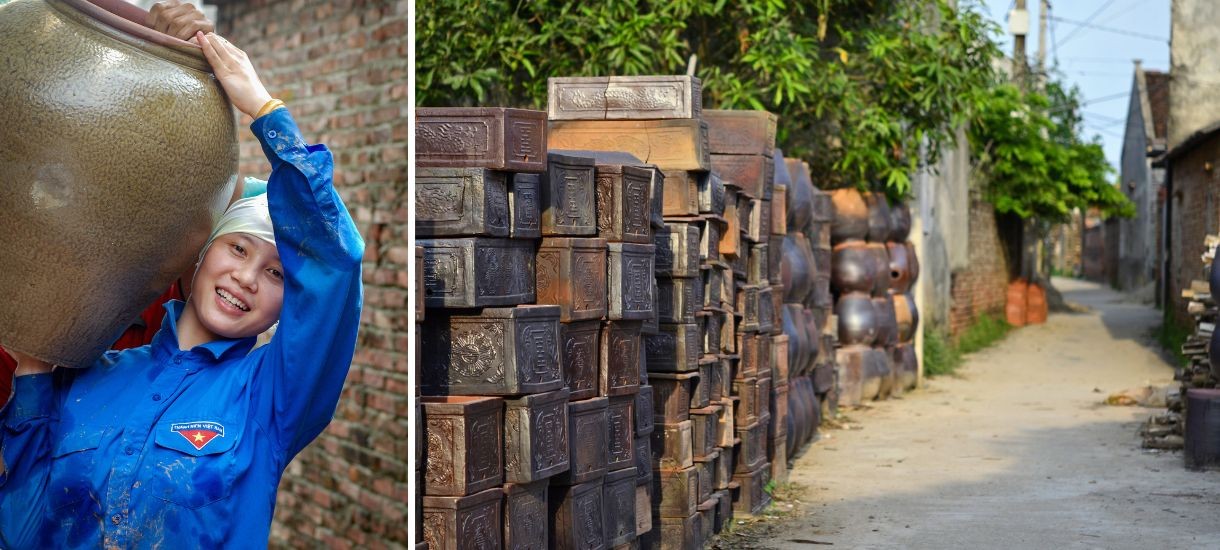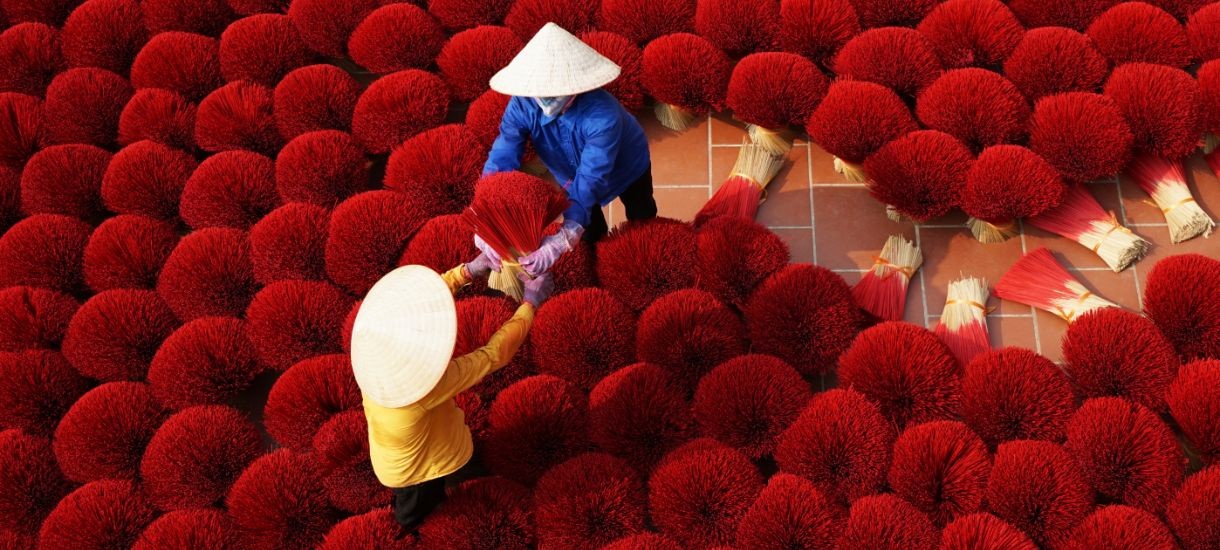Are Younger Generations Interested In Continuing Crafts Like Dong Ho Painting Or Phu Lang Pottery? Absolutely! While modernization poses challenges, many young Vietnamese are embracing and innovating within these traditional art forms. With SIXT.VN, explore Vietnam’s rich cultural heritage and discover how tradition and modernity intertwine through convenient travel services. Visit SIXT.VN to plan your cultural journey today!
1. What is the Current State of Traditional Handicrafts in Vietnam?
The current state of traditional handicrafts in Vietnam is vibrant but faces challenges. Vietnam boasts over 5,000 handicraft villages, with Hanoi and its surroundings being particularly active hubs. These villages specialize in various crafts like bamboo weaving, bronze casting, embroidery, and pottery. Despite the economic shifts and modernization, many artisans are striving to preserve their ancestral skills. According to the Vietnam National Administration of Tourism, craft villages are significant tourist attractions, drawing visitors interested in cultural experiences and unique products.
1.1 What Challenges Do These Handicraft Villages Face?
These handicraft villages face numerous challenges. One of the most significant is economic viability, as mass-produced goods often undercut the prices of handmade items. Maintaining traditional techniques and passing them on to younger generations can also be difficult. Additionally, competition from other industries and the lure of urban jobs can draw young people away from the crafts. Preserving the authenticity and cultural significance of these crafts while adapting to modern market demands is a delicate balancing act.
1.2 What is the role of tourism in sustaining these crafts?
Tourism plays a crucial role in sustaining these crafts. It provides artisans with a direct market for their products, boosting their income and incentivizing them to continue their work. Cultural tourism also raises awareness and appreciation for these traditional skills, both domestically and internationally. According to a report by the General Statistics Office of Vietnam, craft villages that attract tourists often experience higher economic stability and are better able to preserve their cultural heritage. Moreover, tourism encourages the development of related services, such as guided tours and workshops, further supporting the local economy.
 Pottery products in Phu Lang Village showcase the village's distinctive light brown glaze, setting it apart from other pottery centers like Bat Trang.
Pottery products in Phu Lang Village showcase the village's distinctive light brown glaze, setting it apart from other pottery centers like Bat Trang.
2. Are Younger Generations Interested in Continuing These Crafts?
Yes, younger generations are showing increased interest in continuing traditional crafts. Many young Vietnamese are recognizing the cultural and economic value of these skills and are seeking ways to modernize and sustain them. This includes using social media to promote their products, incorporating new designs, and leveraging technology to improve production processes. The revival of interest is also fueled by a growing appreciation for cultural heritage and a desire to connect with their roots.
2.1 What Initiatives Are There to Encourage Youth Involvement?
There are several initiatives aimed at encouraging youth involvement in traditional crafts. Government programs, NGOs, and cultural organizations are providing training, funding, and marketing support to young artisans. Craft villages are also organizing workshops and educational programs to teach young people the skills and knowledge needed to continue these traditions. According to UNESCO, which supports several cultural preservation projects in Vietnam, these initiatives are crucial for ensuring the long-term survival of traditional crafts. Furthermore, some universities and vocational schools are incorporating courses on traditional crafts into their curriculum, providing students with a formal education in these art forms.
2.2 How Are Young Artisans Modernizing Traditional Crafts?
Young artisans are modernizing traditional crafts in several innovative ways. They are using digital platforms to market and sell their products globally, reaching a wider audience. They are also experimenting with new materials and designs, blending traditional techniques with contemporary aesthetics to create unique and appealing products. Moreover, young artisans are adopting sustainable practices and ethical sourcing to appeal to environmentally conscious consumers. By combining tradition with innovation, they are making these crafts relevant and attractive to modern markets.
3. What is Dong Ho Painting and Why is it Significant?
Dong Ho painting is a traditional form of Vietnamese woodblock printing originating from Dong Ho village, near Hanoi. These paintings are known for their vibrant colors, simple yet expressive designs, and cultural themes depicting everyday life, folk tales, and wishes for prosperity. They were traditionally displayed during Tet (Vietnamese New Year) as symbols of good luck and happiness. Dong Ho paintings are significant because they reflect the cultural values, beliefs, and artistic heritage of the Vietnamese people.
3.1 What Themes and Techniques Are Unique to Dong Ho Paintings?
Unique themes in Dong Ho paintings include images of daily life, such as farming, fishing, and family activities. Folk tales, historical figures, and wishes for prosperity and happiness are also common. The techniques involve carving intricate designs into wooden blocks, which are then used to print the images onto Dó paper, a special type of paper made from the bark of the Dó tree. Natural pigments derived from plants and minerals are used to create the vibrant colors, and each color is printed separately, requiring meticulous alignment and precision.
3.2 How Are Efforts Being Made to Preserve Dong Ho Painting?
Efforts to preserve Dong Ho painting include government support for the remaining artisan families in Dong Ho village. Cultural organizations are also promoting workshops, exhibitions, and educational programs to raise awareness and teach the techniques of Dong Ho painting to younger generations. According to the Vietnam Institute for Art and Cultural Studies, these efforts are aimed at revitalizing the craft and ensuring its survival in the face of modernization. Additionally, some artists are experimenting with new themes and designs while staying true to the traditional techniques, making the art form more appealing to contemporary audiences.
.jpg)
4. What is Phu Lang Pottery and Why is it Important?
Phu Lang pottery is a traditional form of Vietnamese ceramics originating from Phu Lang village, located about 60 kilometers east of Hanoi. Known for its distinctive light brown glaze and durable products, Phu Lang pottery includes items such as cooking pots, jars, tiles, and burial caskets. The pottery is important because it reflects the unique cultural and historical identity of Phu Lang village and showcases the traditional craftsmanship of the Red River Delta region.
4.1 What Distinguishes Phu Lang Pottery from Other Pottery Villages?
Phu Lang pottery is distinguished by its unique light brown glaze, which is achieved through a traditional firing process using wood-fired kilns. The village also specializes in larger, more utilitarian items such as cooking pots and burial caskets, setting it apart from other pottery villages like Bat Trang, which is known for its more decorative and refined ceramics. The use of traditional kilns and hand-thrown techniques also contributes to the unique character of Phu Lang pottery.
4.2 How Can One Experience Phu Lang Pottery Firsthand?
One can experience Phu Lang pottery firsthand by visiting Phu Lang village, where you can observe artisans at work, explore the workshops, and purchase pottery directly from the makers. Many families in the village have been practicing pottery for generations, and visitors can learn about the history and techniques of the craft. With SIXT.VN, you can arrange transportation and tours to Phu Lang village, making your visit convenient and enjoyable. Contact SIXT.VN via Hotline/Whatsapp: +84 986 244 358 or visit our website at SIXT.VN.
5. What are the Economic and Cultural Benefits of Preserving These Crafts?
Preserving traditional crafts like Dong Ho painting and Phu Lang pottery offers significant economic and cultural benefits. Economically, these crafts provide livelihoods for artisans and their families, support local economies, and attract tourists, boosting revenue. Culturally, they preserve the unique heritage, traditions, and artistic expressions of Vietnam, contributing to the nation’s cultural identity. Preserving these crafts also fosters a sense of community, pride, and cultural continuity, passing down valuable skills and knowledge to future generations.
5.1 How Do These Crafts Contribute to Local Economies?
These crafts contribute to local economies by providing income for artisans, creating jobs in related industries (such as tourism and marketing), and attracting tourists who spend money on accommodation, food, and transportation. According to the Ministry of Culture, Sports and Tourism of Vietnam, craft villages that successfully preserve their traditions and attract tourists often experience significant economic growth. Moreover, the production and sale of these crafts support local businesses and supply chains, creating a multiplier effect that benefits the entire community.
5.2 What Role Do They Play in Vietnam’s Cultural Identity?
These crafts play a vital role in Vietnam’s cultural identity by embodying the nation’s history, values, and artistic traditions. They reflect the unique characteristics of different regions and communities, showcasing the diversity and richness of Vietnamese culture. Dong Ho paintings, for example, depict scenes of rural life and folk tales, preserving cultural memories and transmitting them to future generations. Phu Lang pottery reflects the craftsmanship and utilitarian traditions of the Red River Delta. By preserving these crafts, Vietnam maintains its cultural heritage and reinforces its identity on the world stage.
6. How Can Tourists Engage with and Support These Crafts?
Tourists can engage with and support these crafts in several meaningful ways. Visiting craft villages, purchasing products directly from artisans, participating in workshops, and learning about the history and techniques of the crafts are all excellent ways to show support. Tourists can also promote these crafts by sharing their experiences on social media, writing reviews, and recommending them to friends and family. By being responsible and informed consumers, tourists can contribute to the economic sustainability and cultural preservation of these traditional crafts.
6.1 What are Some Responsible Tourism Practices in Craft Villages?
Responsible tourism practices in craft villages include respecting local customs and traditions, asking permission before taking photos, and bargaining fairly when purchasing products. It is also important to support local businesses and accommodations, minimize environmental impact by reducing waste and conserving resources, and be mindful of cultural sensitivities. According to the Tourism Concern organization, responsible tourism can empower local communities, protect cultural heritage, and promote sustainable development.
6.2 What Souvenirs Can Tourists Purchase to Support These Crafts?
Tourists can purchase a variety of souvenirs to support these crafts. Dong Ho paintings, Phu Lang pottery, handwoven textiles, lacquerware, and bamboo products are all excellent choices. When purchasing souvenirs, it is important to buy directly from artisans or local cooperatives to ensure that the money goes directly to the makers. Look for items that are authentic, well-made, and reflect the unique cultural heritage of the region. By choosing meaningful and locally sourced souvenirs, tourists can contribute to the economic sustainability of these crafts and help preserve Vietnam’s cultural traditions.
 Incense sticks drying in Quang Phu Cau Village, showcasing the meticulous process and vibrant colors that characterize this traditional craft.
Incense sticks drying in Quang Phu Cau Village, showcasing the meticulous process and vibrant colors that characterize this traditional craft.
7. What Role Does Technology Play in Preserving Traditional Crafts?
Technology plays a crucial role in preserving traditional crafts by enabling artisans to market their products globally, improve production processes, and share their knowledge with wider audiences. E-commerce platforms, social media, and online marketplaces allow artisans to reach customers around the world, boosting their income and incentivizing them to continue their work. Digital design tools and 3D printing can be used to create new designs and prototypes, blending traditional techniques with modern aesthetics. Online tutorials, videos, and virtual workshops can be used to teach the skills and knowledge of traditional crafts to younger generations.
7.1 How Are Artisans Using E-Commerce to Sell Their Products?
Artisans are using e-commerce to sell their products by creating online stores, listing their items on online marketplaces, and using social media to promote their products. Platforms like Etsy, Amazon, and Shopify provide artisans with affordable and easy-to-use tools to reach customers around the world. Social media platforms like Facebook, Instagram, and Pinterest allow artisans to showcase their products, connect with customers, and build their brand. By leveraging e-commerce, artisans can overcome geographical barriers and access new markets, boosting their income and sustaining their craft.
7.2 What Are Some Examples of Digital Innovation in Craft Production?
Examples of digital innovation in craft production include using digital design tools to create new patterns for textiles, using 3D printing to create molds for pottery, and using laser cutting to create intricate designs on wood. Digital fabrication technologies can also be used to automate certain aspects of the production process, improving efficiency and reducing waste. By combining traditional techniques with digital innovation, artisans can create unique and high-quality products that appeal to modern consumers.
8. What Government Policies Support Traditional Crafts in Vietnam?
Government policies in Vietnam support traditional crafts through funding, training, marketing assistance, and cultural preservation programs. The government provides financial support to artisan families, craft villages, and cultural organizations to help them preserve and promote their traditions. Training programs are offered to young people to teach them the skills and knowledge needed to continue these crafts. Marketing assistance is provided to help artisans sell their products domestically and internationally. Cultural preservation programs are implemented to protect and promote the cultural heritage of craft villages.
8.1 What Financial Assistance is Available for Artisans?
Financial assistance available for artisans includes grants, loans, subsidies, and tax incentives. The government provides grants to artisan families to help them purchase materials, equipment, and tools. Low-interest loans are offered to artisans to help them expand their businesses and invest in new technologies. Subsidies are provided to help artisans cover the costs of production and marketing. Tax incentives are offered to encourage investment in craft villages and support the development of traditional crafts.
8.2 What Cultural Preservation Programs Exist?
Cultural preservation programs in Vietnam include the restoration of historical buildings and cultural sites in craft villages, the documentation and preservation of traditional knowledge and skills, and the promotion of cultural festivals and events. The government also supports the establishment of museums, cultural centers, and educational programs to raise awareness and appreciation for traditional crafts. These programs are aimed at protecting and promoting the cultural heritage of craft villages and ensuring the long-term survival of traditional crafts.
9. How Can SIXT.VN Enhance Your Experience Exploring Vietnamese Crafts?
SIXT.VN can enhance your experience exploring Vietnamese crafts by providing convenient and reliable transportation, accommodation, and tour services. With SIXT.VN, you can easily arrange transportation to craft villages, book accommodations in local guesthouses or hotels, and join guided tours to learn about the history and techniques of the crafts. Our services are designed to make your travel experience seamless and enjoyable, allowing you to focus on discovering the rich cultural heritage of Vietnam.
9.1 What Transportation Options Does SIXT.VN Offer?
SIXT.VN offers a variety of transportation options to suit your needs, including airport transfers, private car rentals, and chauffeured services. Our professional drivers are knowledgeable about the local area and can provide valuable insights and recommendations. With SIXT.VN, you can travel comfortably and safely to craft villages and other cultural attractions throughout Vietnam. Contact SIXT.VN via Hotline/Whatsapp: +84 986 244 358 or visit our website at SIXT.VN.
9.2 How Can You Book a Tour to Visit Craft Villages with SIXT.VN?
You can easily book a tour to visit craft villages with SIXT.VN by visiting our website or contacting our customer service team. We offer a variety of tour packages that include transportation, accommodation, and guided visits to craft villages. Our experienced tour guides will provide you with in-depth knowledge about the history, techniques, and cultural significance of the crafts. With SIXT.VN, you can enjoy a hassle-free and enriching experience exploring the traditional crafts of Vietnam.
.jpg)
10. What are Some Lesser-Known Craft Villages Worth Visiting?
While Bat Trang and Dong Ho are well-known, several lesser-known craft villages are worth visiting. These include Xuan Lai, famous for burnt bamboo furniture, and Thu Sy, known for bamboo fish traps. Canh Hoach is renowned for birdcages and purple paper fans, while Ha Thai specializes in lacquerware. These villages offer a more authentic and intimate experience, allowing you to connect with local artisans and learn about their unique traditions.
10.1 What is Unique About Xuan Lai Burnt Bamboo Furniture?
What sets Xuan Lai burnt bamboo furniture apart is its distinctive dark brown color, achieved through a unique smoking process. Bamboos are soaked in ponds for months to increase flexibility, then scorched in kilns using decomposed straw to produce smoke without fire. This process gives the bamboo a shiny, smooth, and dark color, making it highly sought after for creating beds, benches, tables, and decorative items.
10.2 Why is Thu Sy Known for Bamboo Fish Traps?
Thu Sy is known for bamboo fish traps, or Đó, crafted using skills passed down for over two centuries. Artisans meticulously split raw bamboo into thin strips using their hands and chins, then weave them into intricate traps. A smoking technique similar to that used in Xuan Lai gives the traps a golden-brown color. Today, Thu Sy fish traps are not only used by farmers but also as decorative items in hotels and restaurants.
FAQ: Traditional Vietnamese Crafts
1. Why are traditional crafts important in Vietnam?
Traditional crafts are important in Vietnam because they preserve cultural heritage, support local economies, and showcase the country’s artistic identity.
2. What are some famous craft villages near Hanoi?
Some famous craft villages near Hanoi include Bat Trang (ceramics), Dong Ho (paintings), Phu Lang (pottery), and Van Phuc (silk).
3. How can I support artisans in craft villages?
You can support artisans by visiting their villages, purchasing their products directly, and promoting their work on social media.
4. What is Dong Ho painting known for?
Dong Ho painting is known for its vibrant colors, simple designs, and cultural themes depicting everyday life and folk tales.
5. What is Phu Lang pottery famous for?
Phu Lang pottery is famous for its distinctive light brown glaze and durable products like cooking pots and burial caskets.
6. Are younger generations interested in continuing these crafts?
Yes, many young Vietnamese are embracing and innovating within these traditional art forms, blending tradition with modernity.
7. What role does tourism play in preserving crafts?
Tourism provides artisans with a direct market for their products and raises awareness and appreciation for their skills.
8. What government policies support traditional crafts in Vietnam?
Government policies include funding, training, marketing assistance, and cultural preservation programs for artisans and craft villages.
9. How can SIXT.VN help me explore Vietnamese crafts?
SIXT.VN provides convenient transportation, accommodation, and tour services to help you explore craft villages throughout Vietnam. Contact SIXT.VN via Hotline/Whatsapp: +84 986 244 358 or visit our website at SIXT.VN.
10. What are some lesser-known craft villages worth visiting?
Lesser-known craft villages worth visiting include Xuan Lai (burnt bamboo furniture), Thu Sy (bamboo fish traps), and Canh Hoach (birdcages and paper fans).
By addressing these questions and providing comprehensive information, this article aims to capture the attention of readers searching for information on Vietnamese crafts, ensuring it ranks prominently in Google searches and provides valuable insights for those interested in exploring Vietnam’s cultural heritage.
Address: 260 Cau Giay, Hanoi, Vietnam.
Hotline/Whatsapp: +84 986 244 358.
Website: SIXT.VN.




